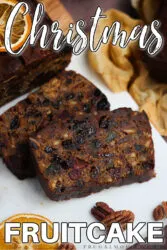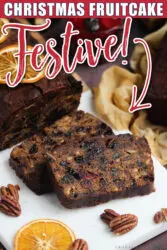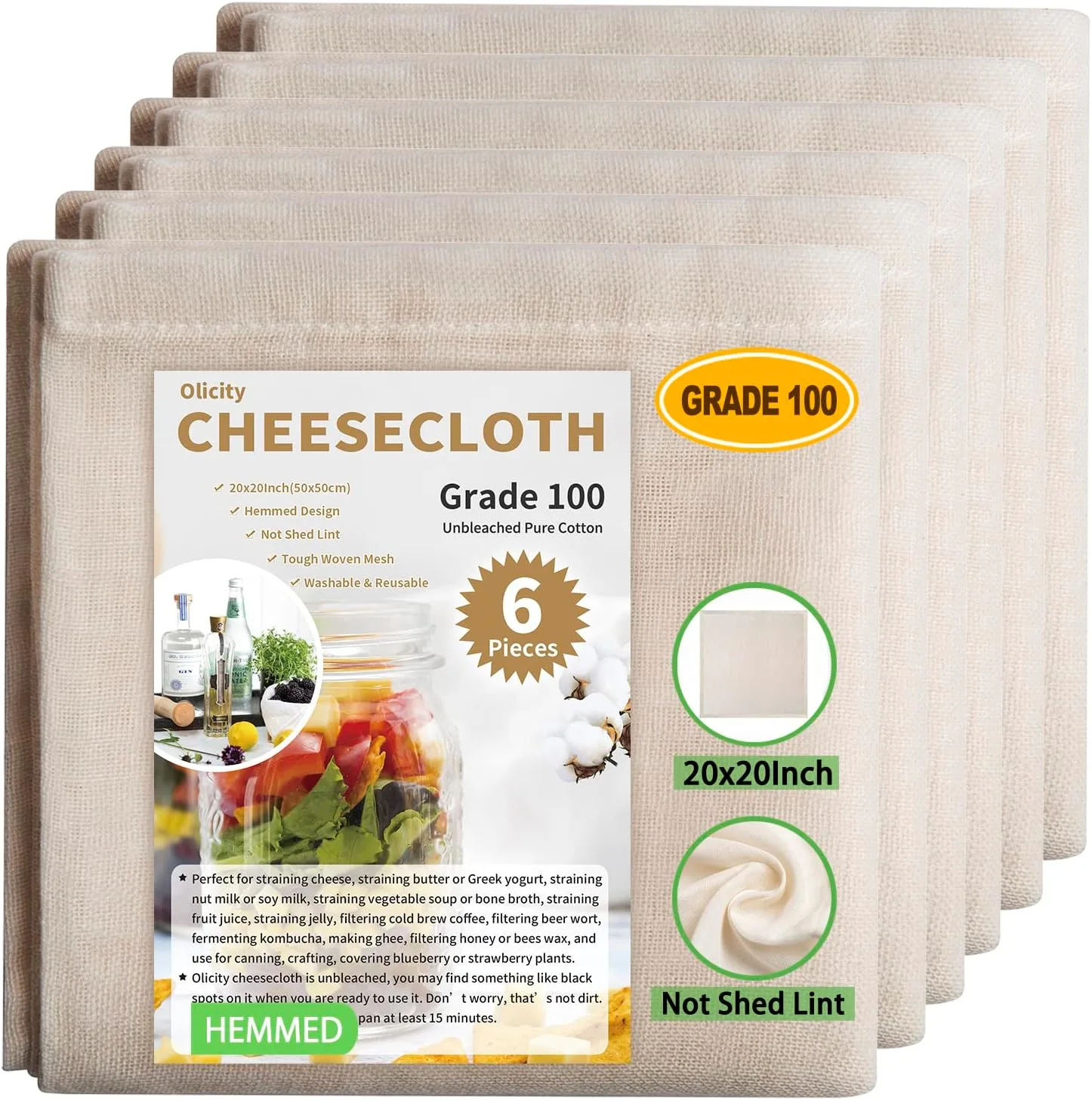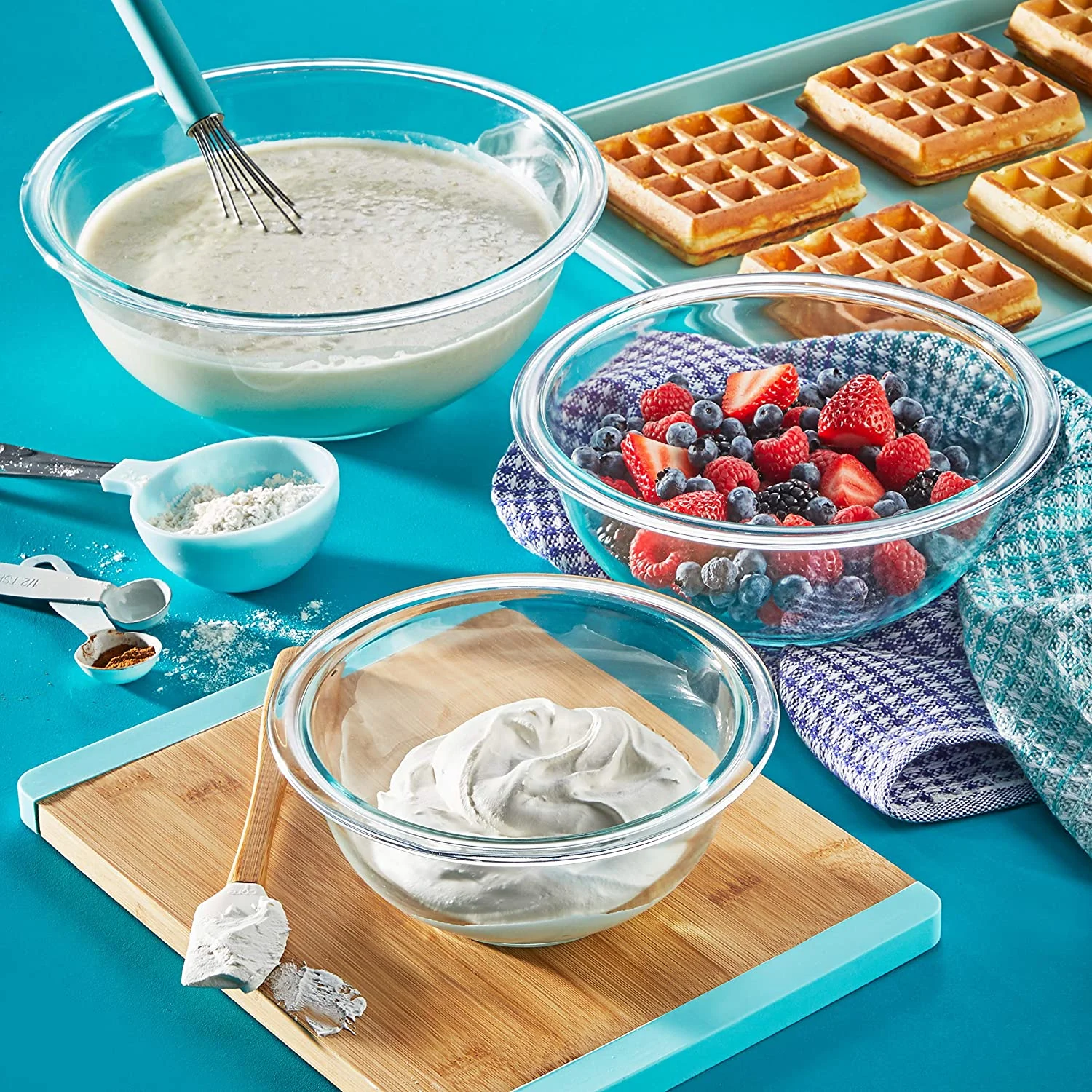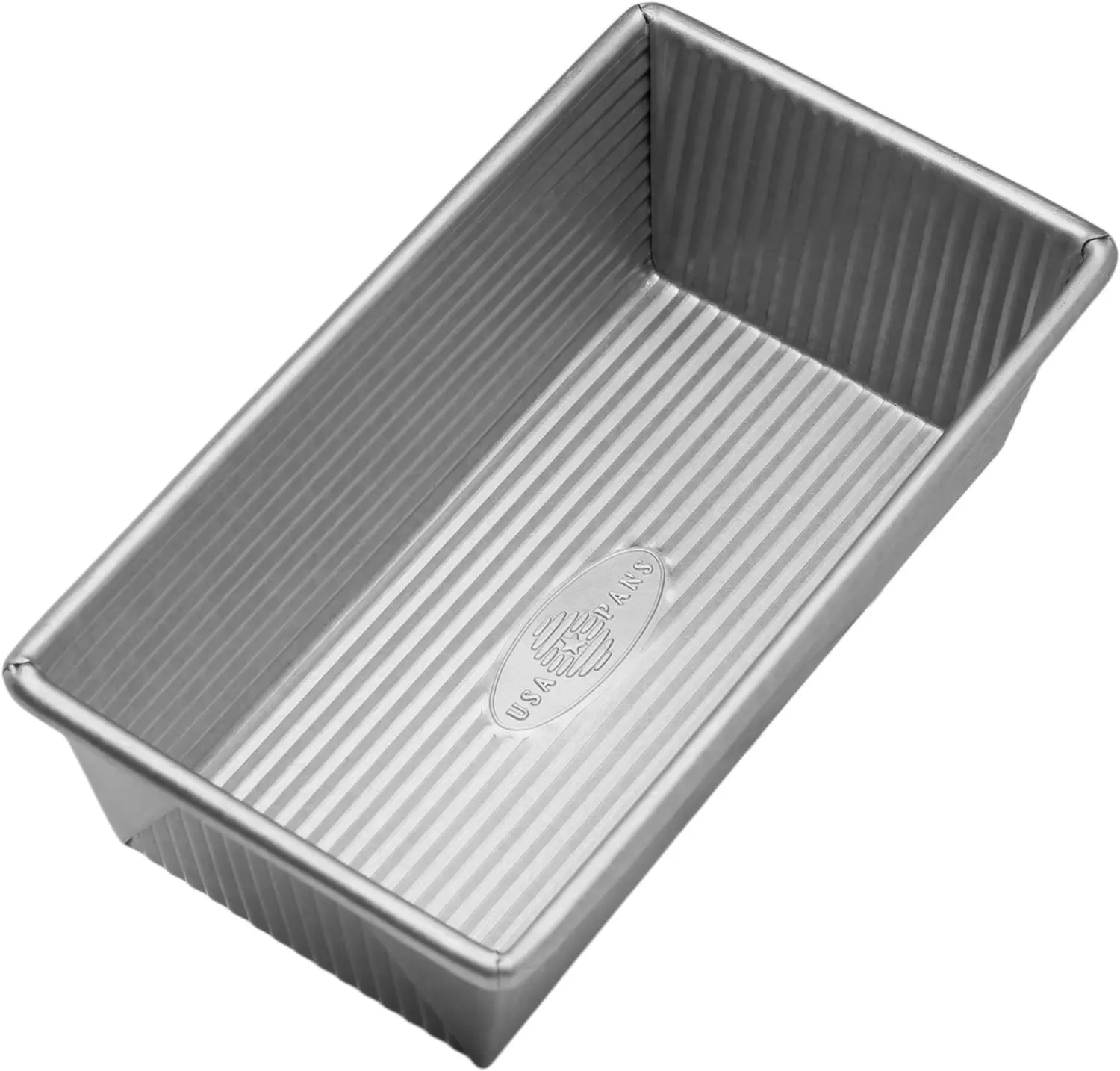Discover the ultimate holiday fruitcake recipe! Bake up a classic fruitcake that will wow even the most discerning fruitcake enthusiast.

Get ready to add a dash of nostalgia and a pinch of holiday cheer to your culinary repertoire because today, we are going to dive headfirst into the delightful world of fruitcake.
Now, I know what you’re thinking – fruitcake? Isn’t that the dense, dry loaf that usually gets passed around like a hot potato during the holiday season? Fruitcake gets a bad rap but I’m here to tell you it’s not deserved.
Prepare to have your taste buds pleasantly surprised because this recipe makes a truly mouthwatering fruitcake that will make you fall in love with this classic treat all over again. It’s moist, not too sweet, lightly spiced and packed with juicy fruit.
So, roll up your sleeves, dust off your mixing bowls, and let’s embark on a delicious baking adventure that will leave your kitchen smelling like a winter wonderland.
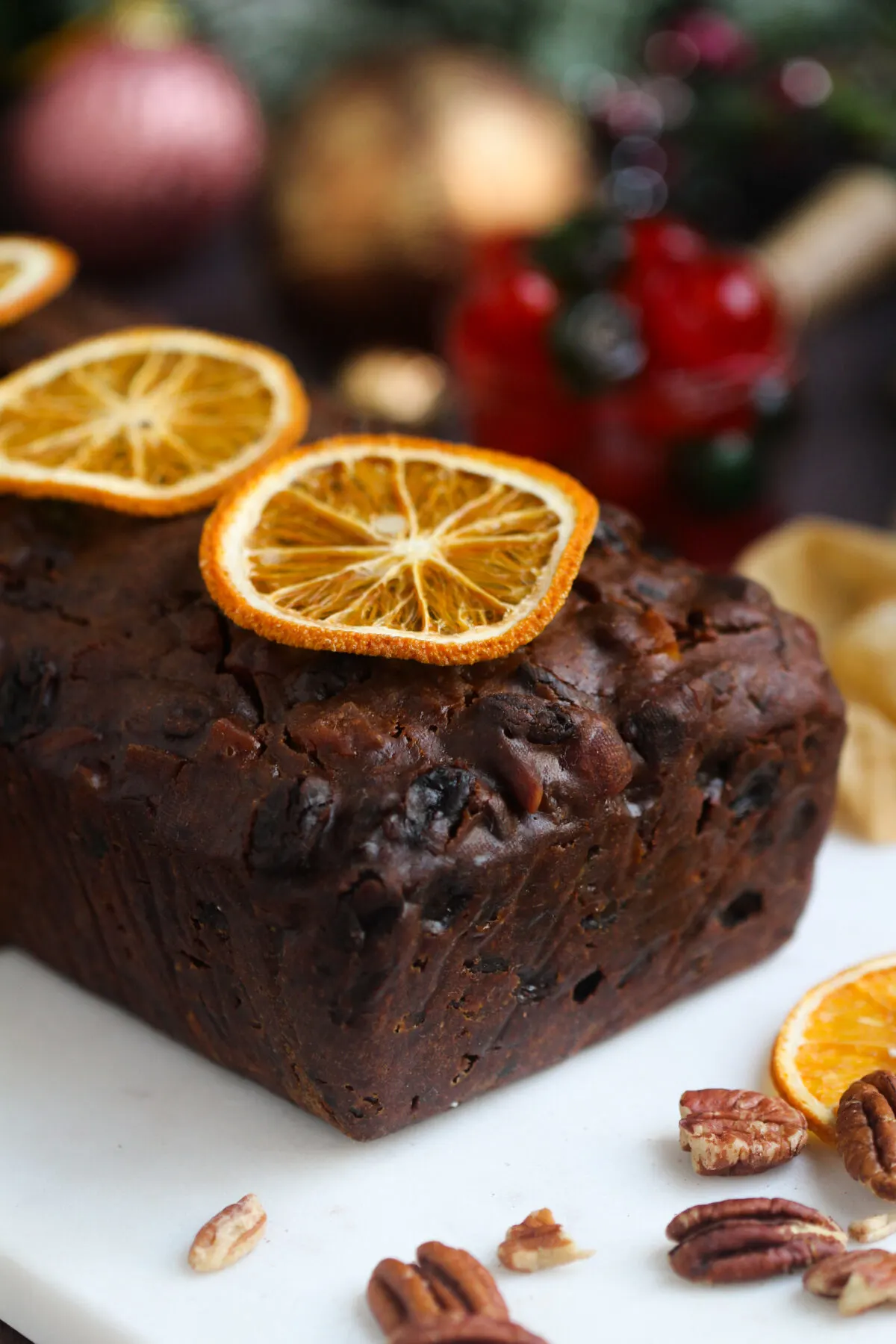
Tips for Making the BEST Fruitcake
- Do use good quality ingredients, and take the time to properly measure each one out. The ingredients for fruitcake are expensive, so don’t waste them by not following the recipe carefully.
- There is no need to soak the fruit ahead of time as we are speeding up the process by simmering the fruit on the stove with spices, sugar, butter, and liqueur. This ensures that the fruit is plump and flavourful without needing a long soaking time.
- Sifting dry ingredients such as flour, baking powder and spices before adding them to the batter can help prevent lumps and ensure even distribution.
- Don’t over-mix the batter. Over-mixing can result in a tough and dry cake. Mix just until all ingredients are incorporated.
- Use good quality pans to bake your fruitcake in. Dark metal pans will distribute heat more evenly, but this can lead to the bottom and sides of your cakes browning or burning. Use light coloured metal pans instead – I used vintage pans; they do not have to be bright and shiny.
- The batter for this fruitcake is dark, so you cannot rely on colour to know when the fruitcakes are done baking. Instead, use a toothpick or skewer inserted in the center of the cake – if it comes out clean, then the cakes are done.
- Once you have removed the fruitcakes from the oven allow them to cool completely in the pans before removing. If you attempt removing the cakes while they are still warm, they may fall apart.
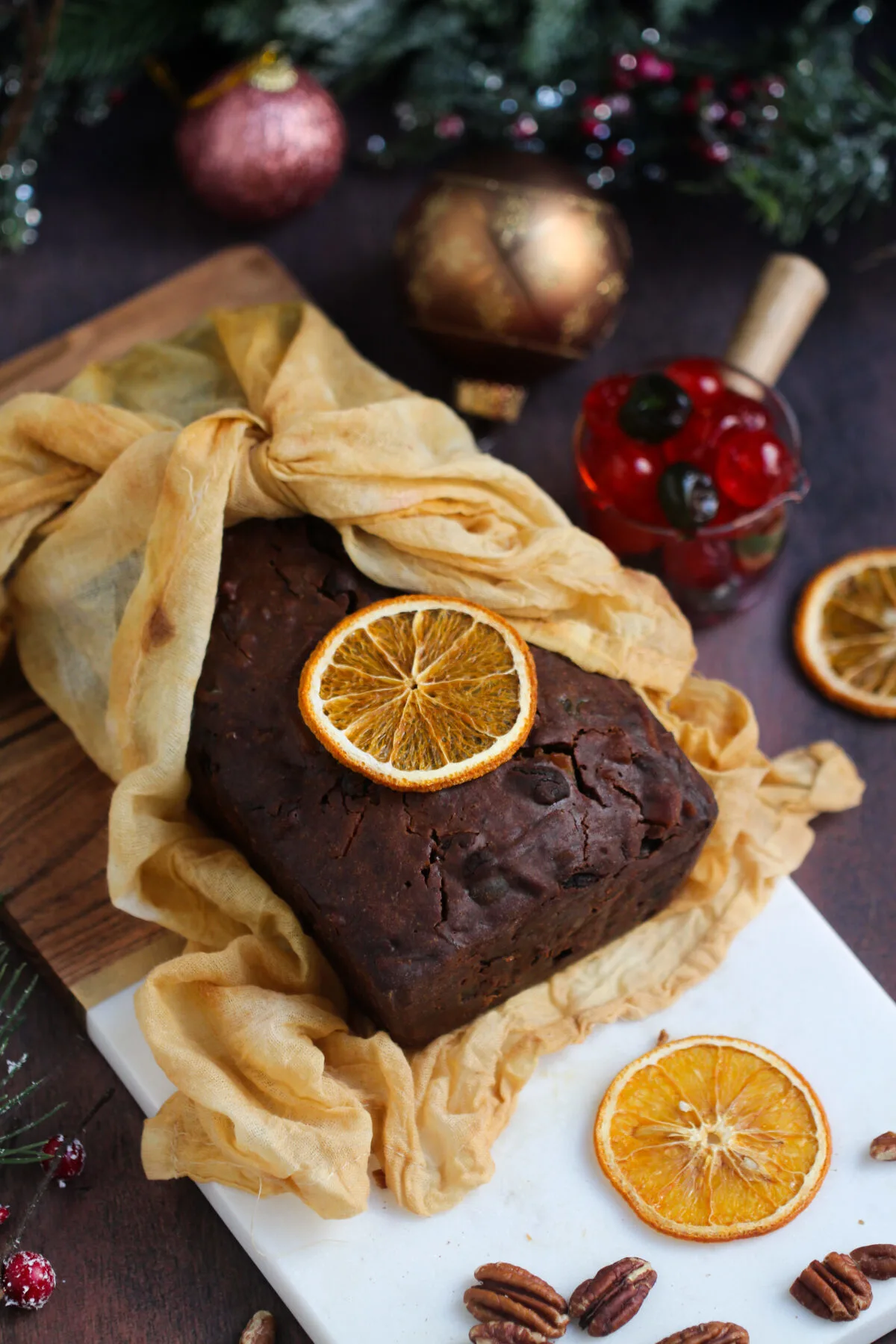
Tips for Maturing your Fruitcake
Fruitcake tastes better after it has matured for at least 6 weeks.
Every week, unwrap the fruitcake and brush it with your desired liquor – rum, brandy, or bourbon. This helps to keep the cake moist and adds extra flavour – as well as helping to preserve the cake. Alternatively, you can soak your cheesecloth in the liquor – be sure to wring it out well before you wrap it around the cake.
You then want to wrap the cheesecloth layer well with plastic wrap before wrapping in foil. Do not allow your cake to touch the foil, as it can alter the flavour of the fruits in the cake. Wrapping the cake in plastic wrap first helps to avoid this from happening.
Store the fruitcake in a cool, dry place. You can also store it in an airtight container or tin if desired. Do not store in the fridge or freezer while maturing the cake.
Do not feed the fruitcake with wine or fruit juice, as this can lead to your fruitcake moulding.
You also do not want to feed the cake any more than 4 times during the maturation period. You should also check the cake for dampness prior to feeding. Over-feeding can result in a soggy cake.
After 6 weeks, your fruitcake will be fully matured and ready to enjoy! You can serve it as is or decorate with icing or marzipan for a special occasion. If you are frosting the cake, do not do so until just before serving.

Equipment Needed for Making Fruitcake
- Large saucepan
- Two standard loaf pans – 8 1/2″ x 4 1/2″ pans with a 6 cup capacity. You can change the pan size, keeping in mind the total capacity. For example, you could use a 10 inch springform pan instead.
- Parchment paper
- Large bowl
- Flour sifter
- Wooden spoon
- Spatula
- Skewer
- Cheesecloth – I used these hemmed cheesecloths which can be washed and re-used.
- Plastic wrap
- Aluminum foil
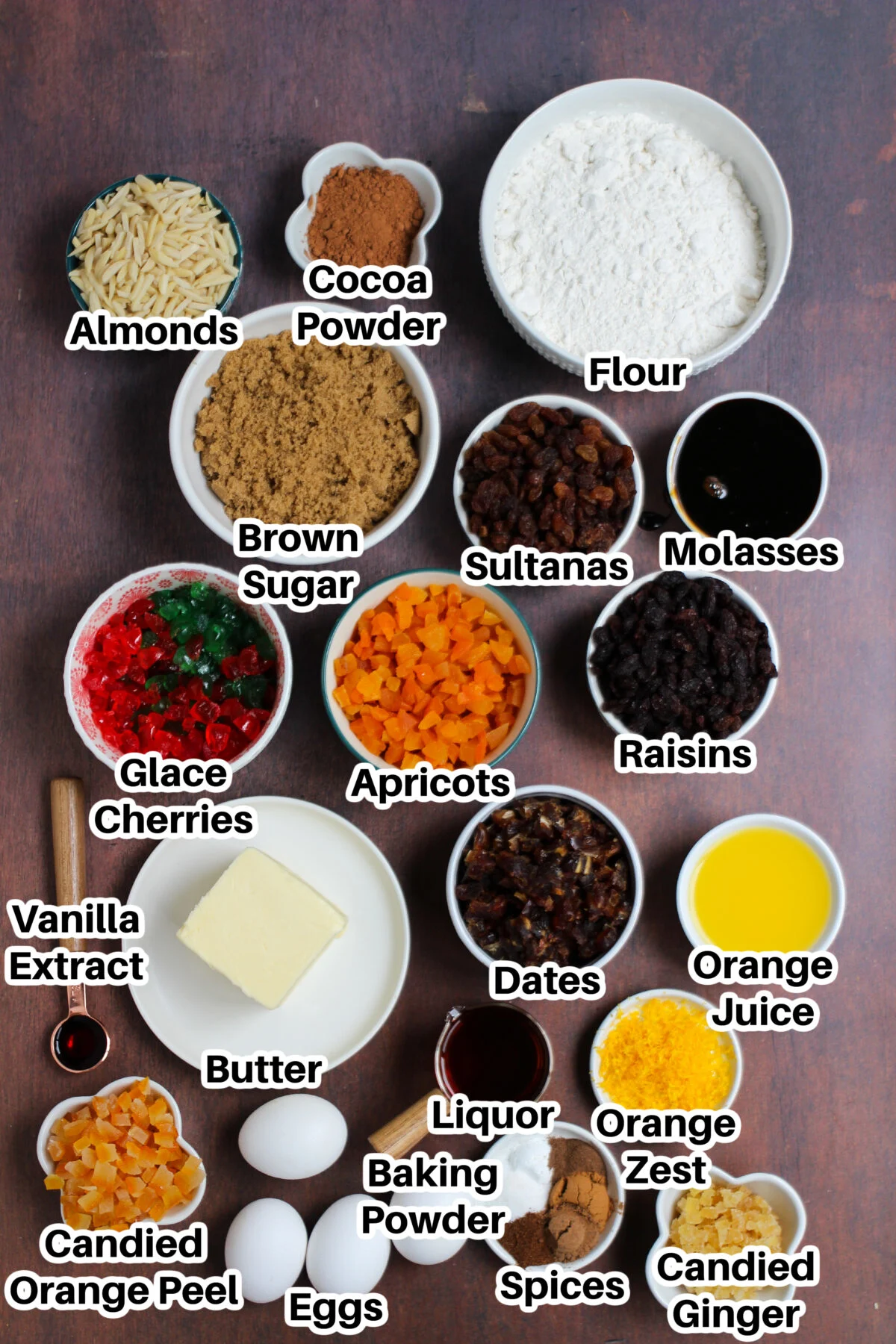
About the Ingredients for Fruitcake
Fruit – Use a mixture of dried and candied fruits. You do not need to use the exact mix I use, but you do need to use the same amount. I used dried apricots, dates, raisins, sultanas, glace cherries, candied citrus peel, and candied ginger. You could substitute any of these with dried pineapple, dried cherries, prunes, currants, or dried cranberries – but keep in mind that at least half your fruits should be candied for best results.
Sugar – Dark brown sugar is best for sweetening the batter. Be sure to pack it well when measuring.
Molasses – Use fancy molasses preferably. You can substitute with black treacle if you like.
Butter – Use unsalted butter for best results. If using salted butter, reduce the additional salt in the batter to 1/2 teaspoon.
Alcohol – You can use rum or brandy – brandy is more traditional, but rum is pretty good too. Bourbon is another great option. For an alcohol free substitution, use apple cider. If using apple cider, and not maturing with alcohol, you will not be able to age the fruitcake, and it should be served within a few days of baking.
Orange – Fresh orange juice and zest is best. You should get a half cup of juice and a generous amount of zest.
Flour – Make sure you spoon and level your flour when measuring. Although fruitcake is dense by nature, using too much flour can make it dry, which is not what we want.
Baking powder – Ensure your baking powder is fresh, no older than 6 months, and still active so your loaves rise properly.
Cocoa powder – Do not use hot chocolate mix. Unsweetened cocoa powder adds some richness and colour to the batter.
Salt – Enhances the flavour of the fruitcake.
Spices – Fruitcake is well-spiced. Use ground allspice, ginger, cloves, and nutmeg.
Eggs – Use room temperature eggs for the best results.
Almonds – Roughly chopped or slivered almonds work great. You can also use chopped pecans or walnuts instead.
Vanilla – Use pure vanilla extract for best results.
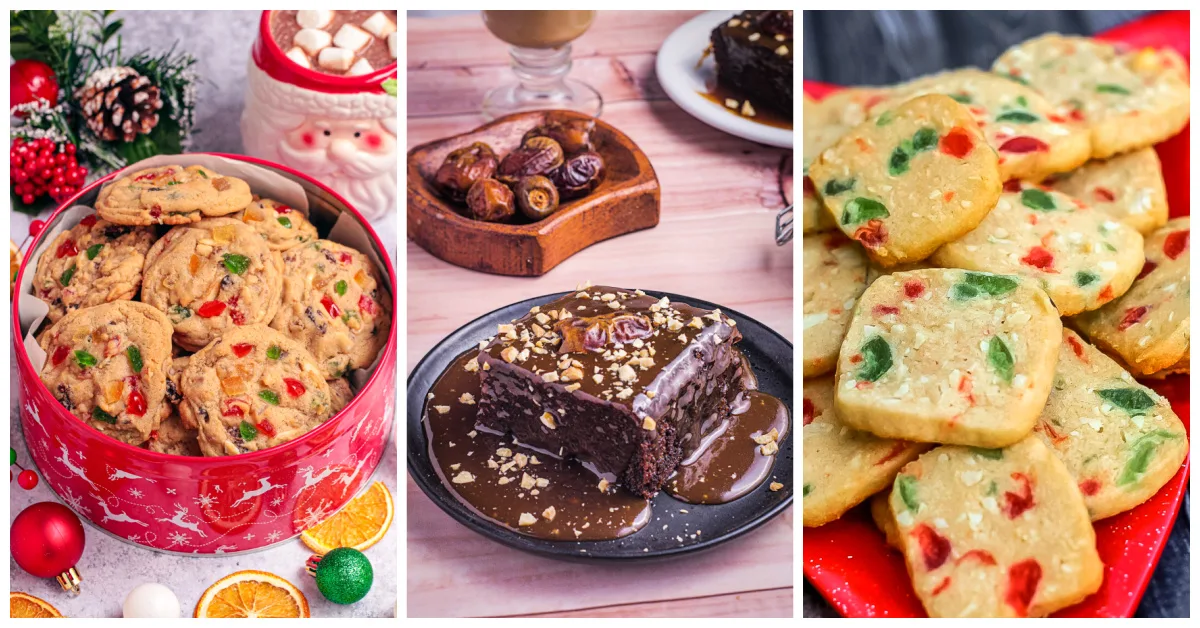
Looking for More Holiday Recipes?
Use up any leftover candied and dried fruit with these delicious holiday recipes!
If you love fruitcake, these delicious and festive fruitcake cookies are the perfect addition to your holiday baking lineup.
Sticky date pudding is rich, sweet and absolutely delicious. Perfect for dessert on a cold winter day, or part of a holiday dessert table!
These Stained Glass Window Shortbread Cookies are a classic Christmas Cookie Recipe featuring candied cherries and ground almonds. Make the dough ahead then slice and bake when ready!
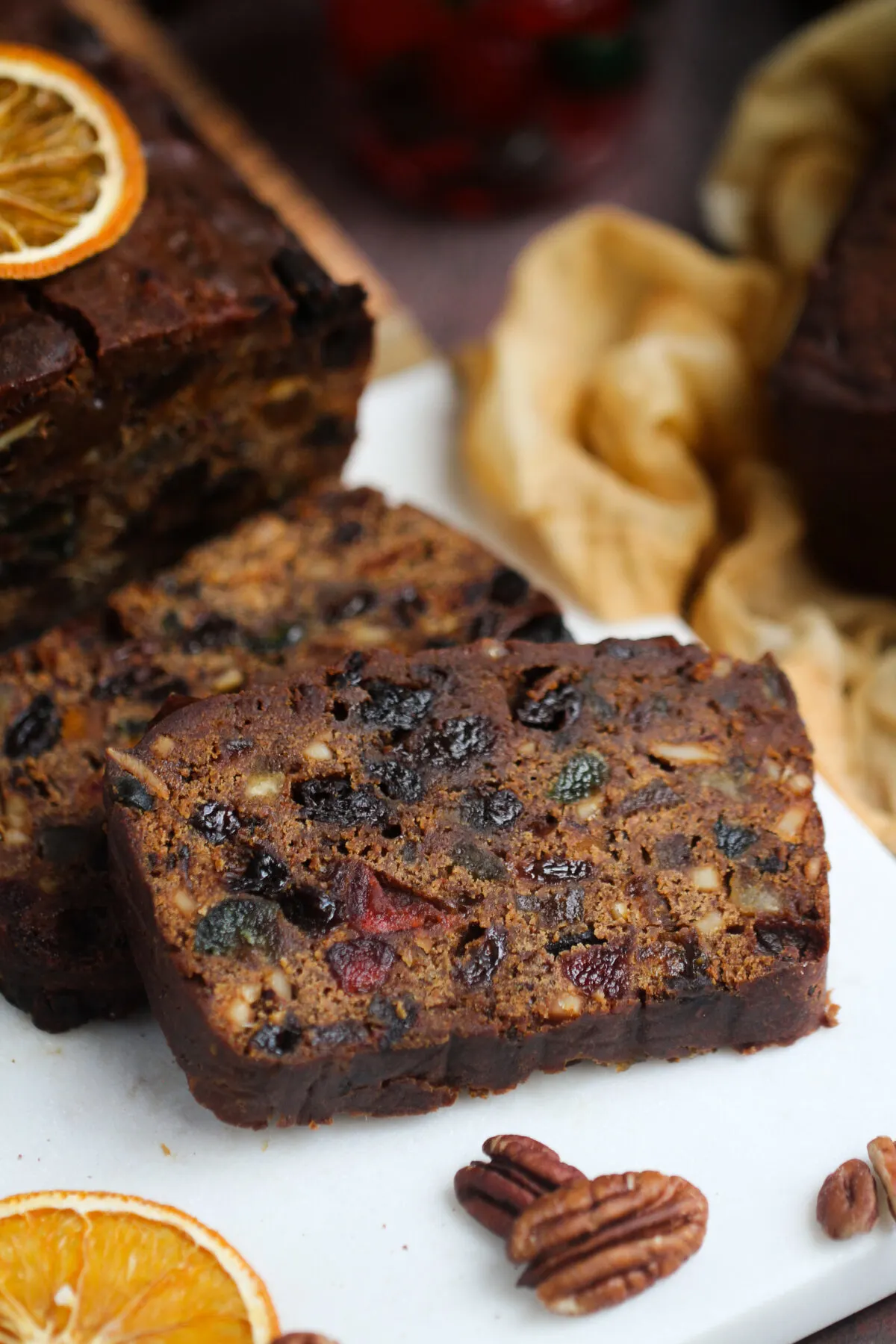
How to Make Fruitcake
Yields: 2 fruitcake loaves | Prep time: 45 Minutes | Cook time: 2 Hours
Ingredients:
For the Fruit:
- 1 1/4 cups (200 g) dried apricots, chopped
- 1 1/4 cups (200 g) dates, chopped
- 1 1/4 cups (200 g) dark raisins
- 1 1/4 cups (200 g) golden raisins (sultanas)
- 1 cup (200 g) dark brown sugar, packed
- ½ cup (150 ml) molasses or black treacle
- 1 cup (227 g) unsalted butter
- ½ cup rum, brandy, plus more for feeding
- Zest and juice of 2 medium oranges (about ½ cup juice)
For the Batter:
- 2½ cups (300 g) all-purpose flour
- ½ teaspoon baking powder
- 3 tablespoons cocoa powder
- 1 teaspoon salt
- ½ teaspoon ground allspice
- 1 teaspoon ground cinnamon
- ½ teaspoon powdered ginger
- ½ teaspoon ground cloves
- 1 teaspoon ground nutmeg
- 4 large eggs
- 1/3 cup (55 g) candied ginger, finely diced
- 1 cup (195 g) glace cherries, chopped
- 1 cup (165 g) candied citrus peel
- 1 cup (130 g) almonds, slivered or roughly chopped
- 1 teaspoon vanilla extract
Instructions
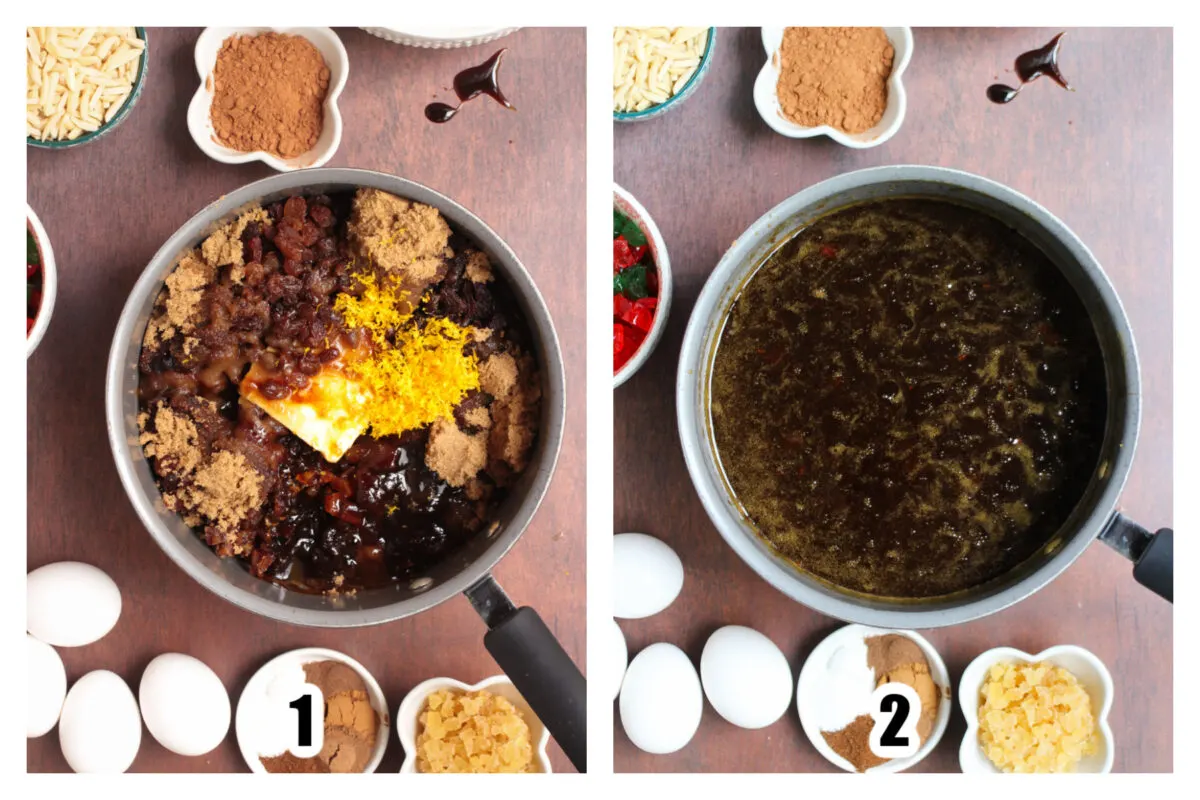
In a large saucepan, set over medium heat, combine the apricots, dates, raisins, brown sugar, molasses, butter, rum (or brandy), and the zest and juice of an orange. (Image 1)
Bring to a boil, then reduce the heat and let it simmer for 5 minutes. Remove from the heat and set aside to cool for 30 minutes. (Image 2)
Preheat the oven to 300° Fahrenheit. Lightly grease two standard loaf pans and line with parchment paper.
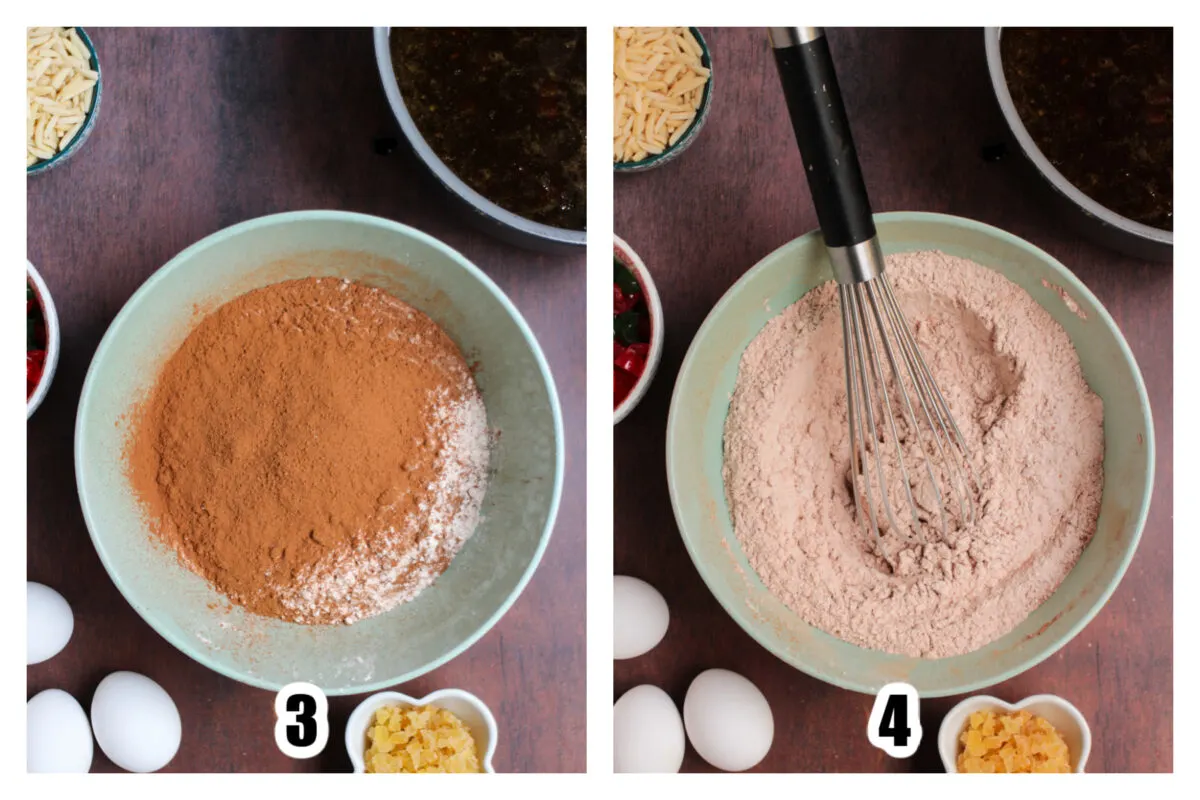
Into a large bowl, sift the flour, cocoa, baking powder, salt, and spices together. (Image 3) Mix until well combined. (Image 4)
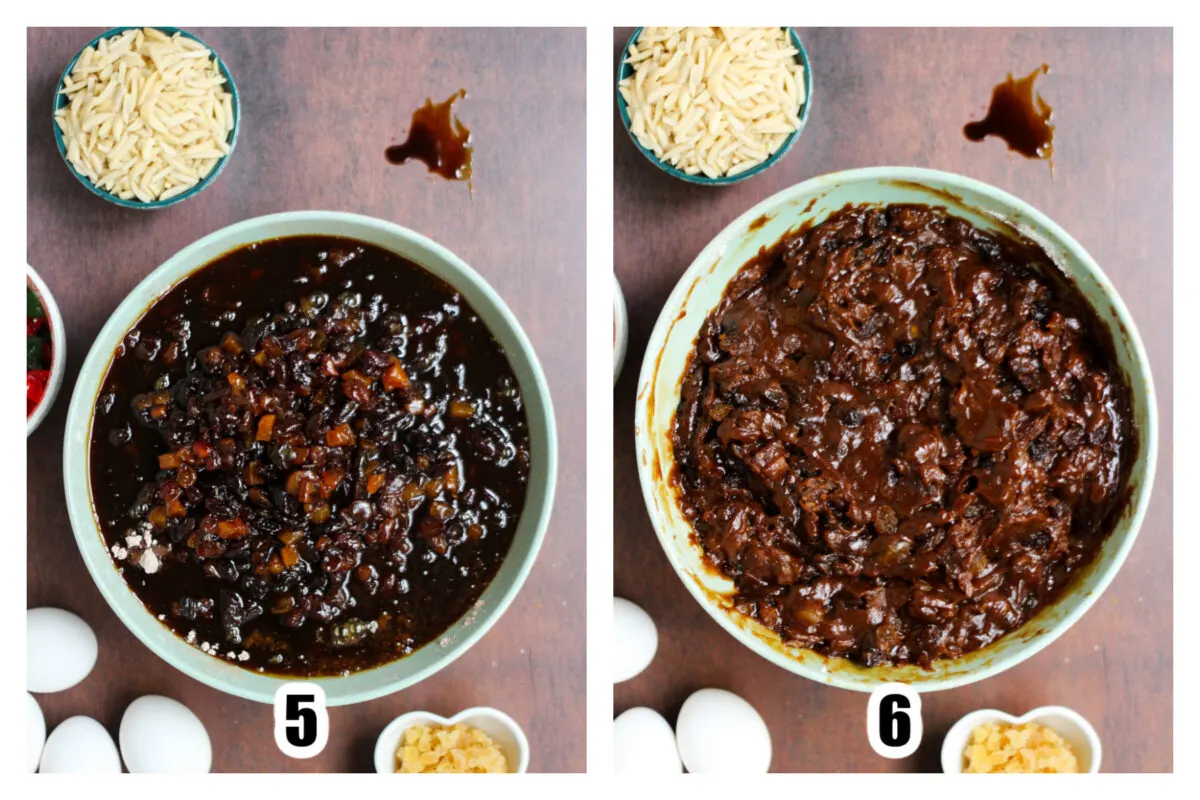
Pour the fruit mixture into the dry ingredients (Image 5), and mix together. (Image 6)
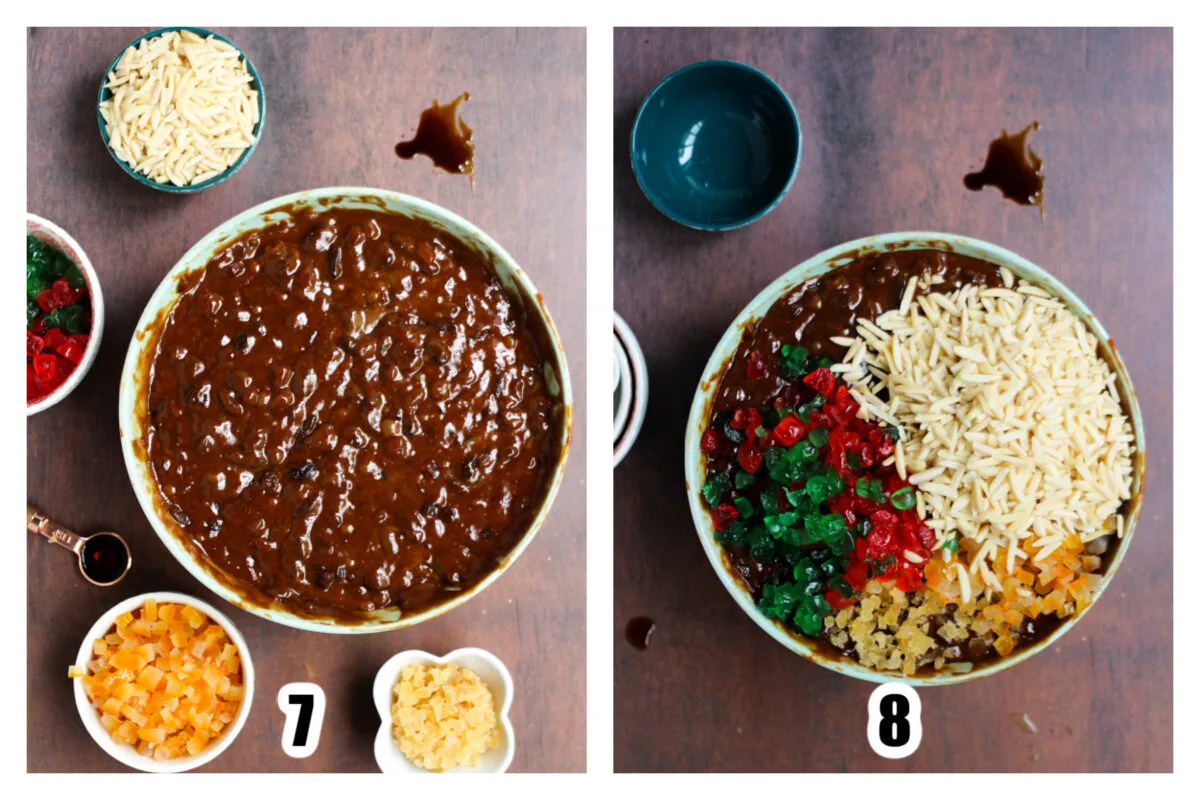
Add the eggs, and vanilla extract. Mix thoroughly to combine, ensuring no dry pockets of ingredients remain. (Image 7) Then add the candied ginger, cherries, candied peels, and almonds. (Image 8)
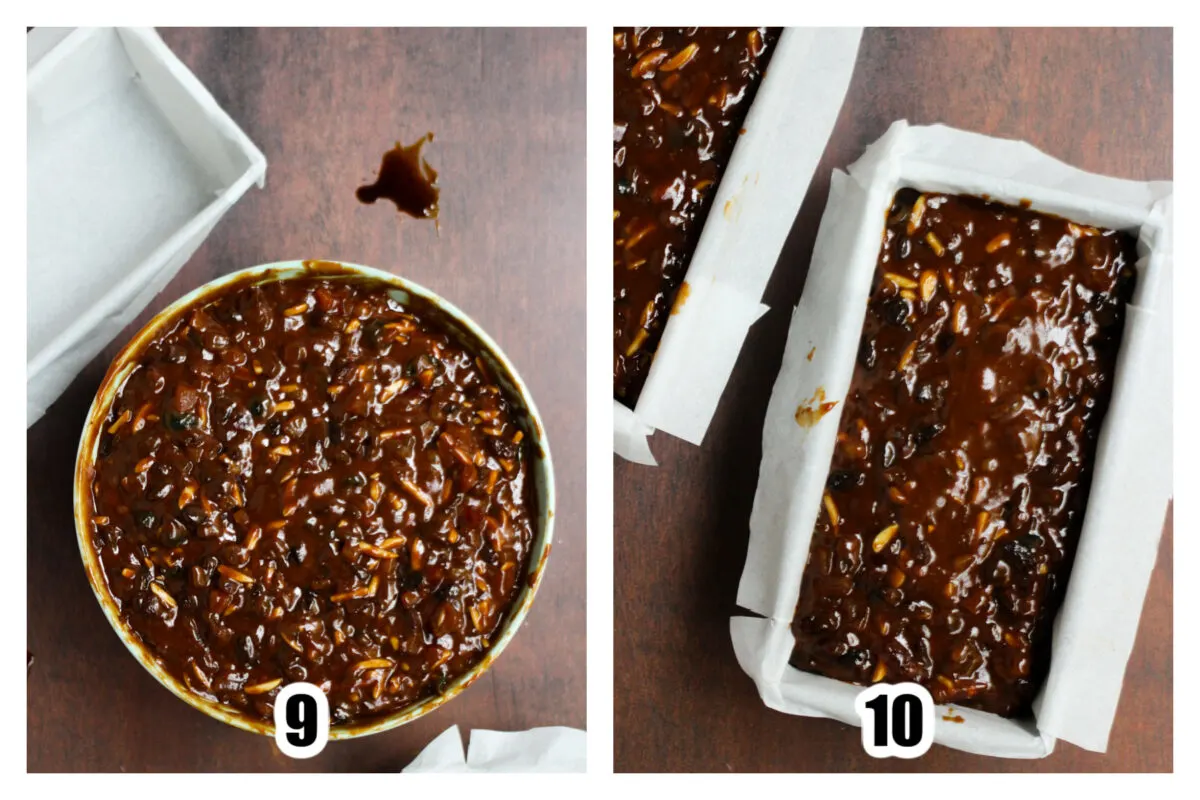
Mix until just combined, do not over mix. (Image 9) Pour the batter into the prepared baking pans, filling them about 3/4 full, using a spatula to level the top. (Image 10)
Bake for 2 hours, rotating the pans halfway through, until the batter is fully set. Test for doneness by poking a skewer into the centre of the cakes. It should come out clean when ready.
Once done, take the pans out of the oven and allow them to cool completely in the pans.
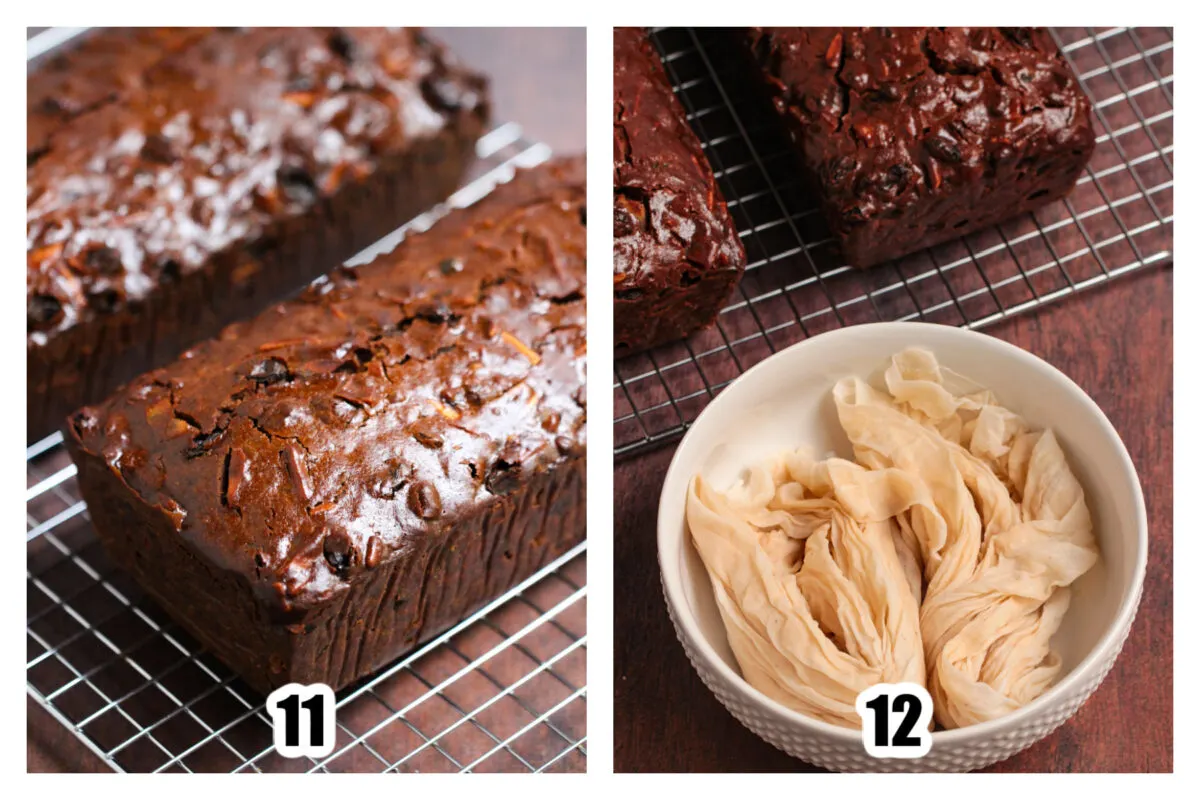
Storing and aging
Once the cake has cooled, carefully remove the cakes from the loaf pans and set upright. (Image 11)
The cake can be served immediately after cooling, but the flavours develop significantly over time. For optimal results, I recommend allowing it to mature for at least 6 weeks before serving. (The cake shown served here is 6 weeks old.)
To begin the maturing process, use a skewer or fork to pierce the loaves all over, then lightly brush the loaves all over with with your preferred alcohol.
Take two generous pieces of cheesecloth and soak them with your preferred alcohol. Make sure they are slightly damp, not overly saturated, when you use them to wrap the cakes. If necessary, gently squeeze out any excess liquid. (Image 12)
Wrap each loaf tightly with the cheesecloth. Cover loaves with plastic wrap and then foil before storing in a cool place. Ensure that your fruitcake and the foil do not make contact with each other.
Unwrap the fruitcake weekly and brush over with a tablespoon of alcohol. Alternatively, you may re-soak the cheesecloth. Wrap the fruitcake back up tightly. This should be done no more than 4 times during the maturation process.
It is possible to over-soak the cake, if the cake seems damp when you unwrap it, skip feeding it for a week.
If there are any signs of mould or if the cake has a fermented, sour, or unusual smell, it is best to discard it. However, if none of these indicators are present, the cake should be safe to consume. Matured fruit cakes, known for their longevity, can be stored for years.
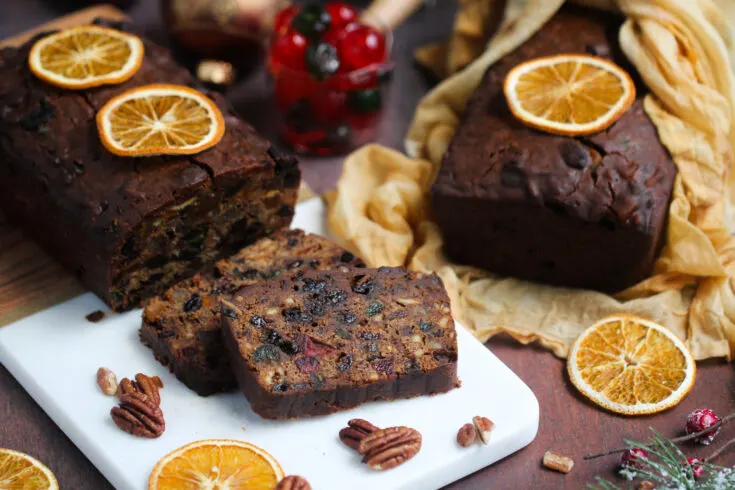
Christmas Fruitcake
Discover the ultimate holiday fruitcake recipe! Bake up a classic fruitcake that will wow even the most discerning fruitcake enthusiast.
Ingredients
For the Fruit:
- 1 1/4 cups (200 g) dried apricots, chopped
- 1 1/4 cups (200 g) dates, chopped
- 1 1/4 cups (200 g) dark raisins
- 1 1/4 cups (200 g) golden raisins (sultanas)
- 1 cup (200 g) dark brown sugar, packed
- ½ cup (150 ml) molasses or black treacle
- 1 cup (227 g) unsalted butter
- ½ cup rum, brandy, plus more for feeding
- Zest and juice of 2 medium oranges (about ½ cup juice)
For the Batter:
- 2½ cups (300 g) all-purpose flour
- ½ teaspoon baking powder
- 3 tablespoons cocoa powder
- 1 teaspoon salt
- ½ teaspoon ground allspice
- 1 teaspoon ground cinnamon
- ½ teaspoon powdered ginger
- ½ teaspoon ground cloves
- 1 teaspoon ground nutmeg
- 4 large eggs
- 1/3 cup (55 g) candied ginger, finely diced
- 1 cup (195 g) glace cherries, chopped
- 1 cup (165 g) candied citrus peel
- 1 cup (130 g) almonds, slivered or roughly chopped
- 1 teaspoon vanilla extract
Instructions
- In a large saucepan, set over medium heat, combine the apricots, dates, raisins, brown sugar, molasses, butter, rum (or brandy), and the zest and juice of an orange.
- Bring to a boil, then reduce the heat and let it simmer for 5 minutes. Remove from the heat and set aside to cool for 30 minutes.
- Preheat the oven to 300° Fahrenheit. Lightly grease two standard loaf pans and line with parchment paper.
- Into a large bowl, sift the flour, cocoa, baking powder, salt, and spices together.
- Pour the fruit mixture into the dry ingredients, followed by the eggs, candied ginger, cherries, candied peels, almonds, and vanilla extract. Mix thoroughly to combine, ensuring no dry pockets of ingredients remain.
- Pour the batter into the prepared baking pans, filling them about 3/4 full, using a spatula to level the top.
- Bake for 2 hours, rotating the pans halfway through, until the batter is fully set. Test for doneness by poking a skewer into the centre of the cakes. It should come out clean when ready.
- Once done, take the pans out of the oven and allow them to cool completely in the pans.
Storing and aging
- Once the cake has cooled, carefully remove the cakes from the loaf pans and set upright.
- The cake can be served immediately after cooling, but the flavours develop significantly over time. For optimal results, I recommend allowing it to mature for at least 6 weeks before serving. (The cake shown served here is 6 weeks old.)
- To begin the maturing process, use a skewer or fork to pierce the loaves all over, then lightly brush the loaves all over with with your preferred alcohol.
- Take two generous pieces of cheesecloth and soak them with your preferred alcohol. Make sure they are slightly damp, not overly saturated, when you use them to wrap the cakes. If necessary, gently squeeze out any excess liquid.
- Wrap each loaf tightly with the cheesecloth. Cover loaves with plastic wrap and then foil before storing in a cool place. Ensure that your fruitcake and the foil do not make contact with each other.
- Unwrap the fruitcake weekly and brush over with a tablespoon of alcohol. Alternatively, you may re-soak the cheesecloth. Wrap the fruitcake back up tightly. This should be done no more than 4 times during the maturation process.
- It is possible to over-soak the cake, if the cake seems damp when you unwrap it, skip feeding it for a week.
- If there are any signs of mould or if the cake has a fermented, sour, or unusual smell, it is best to discard it. However, if none of these indicators are present, the cake should be safe to consume. Matured fruit cakes, known for their longevity, can be stored for years.
Recommended Products
As an Amazon Associate and member of other affiliate programs, I earn from qualifying purchases.
Nutrition Information:
Yield:
24Serving Size:
1 oz sliceAmount Per Serving: Calories: 124Total Fat: 2gSaturated Fat: 1gTrans Fat: 0gUnsaturated Fat: 1gCholesterol: 32mgSodium: 122mgCarbohydrates: 22gFiber: 1gSugar: 10gProtein: 3g
This information is provided as a courtesy and for entertainment purposes only. This information comes from online calculators. Although frugalmomeh.com attempts to provide accurate nutritional information, these figures are only estimates.
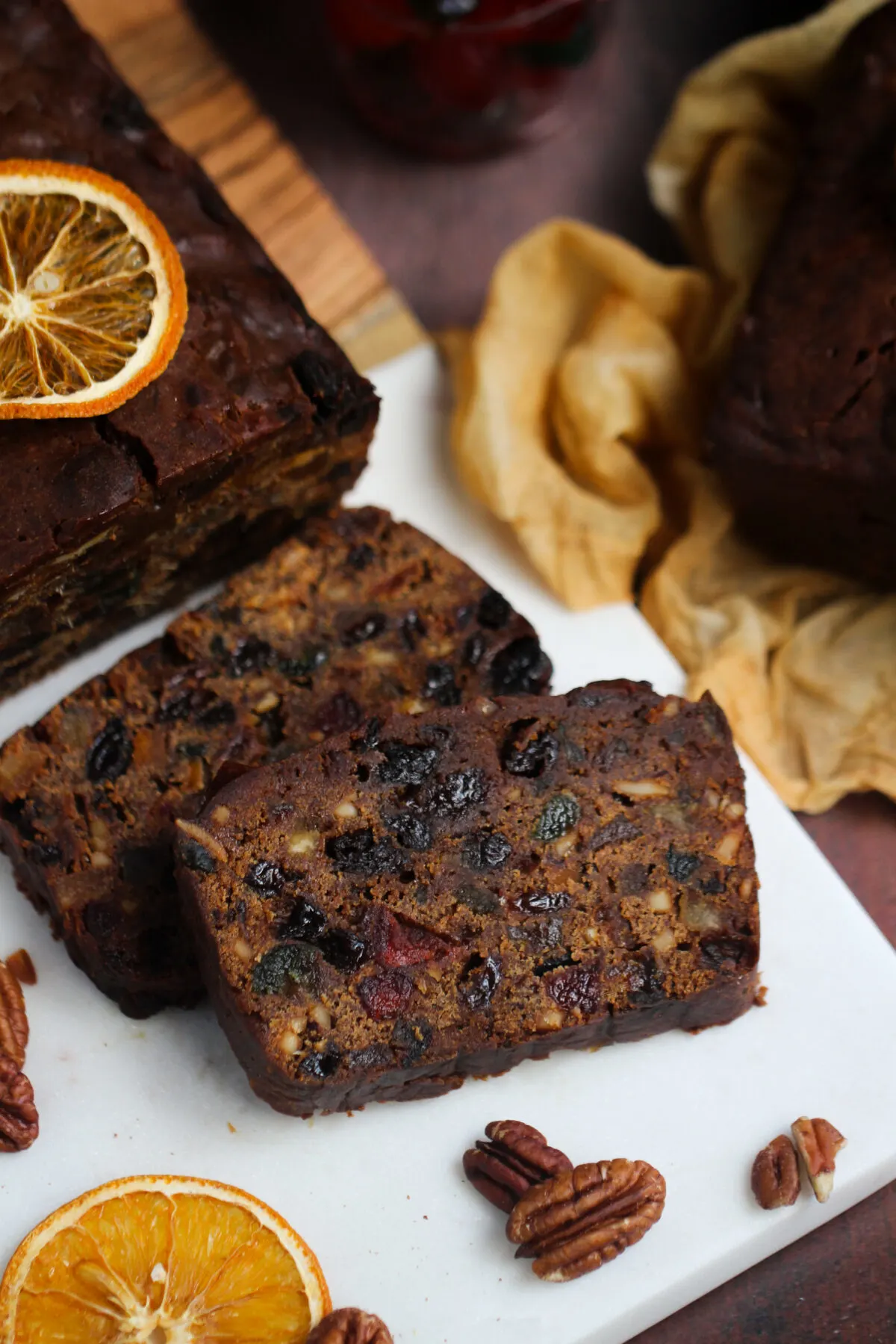

Elizabeth Lampman is a coffee-fuelled Mom of 2 girls and lives in Hamilton, Ontario. She enjoys travelling, developing easy recipes, crafting, taking on diy projects, travelling and saving money!


